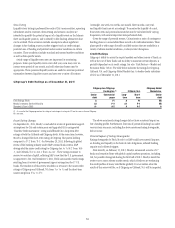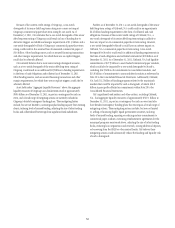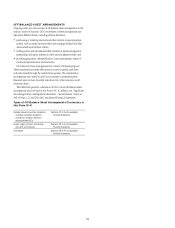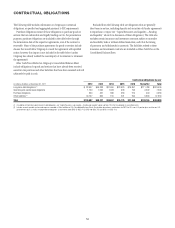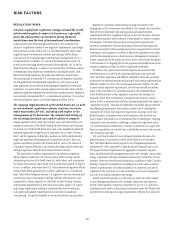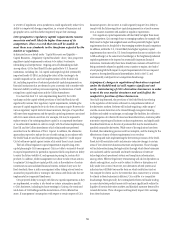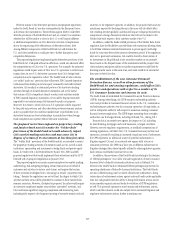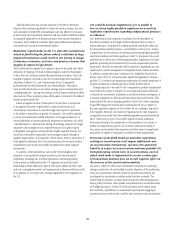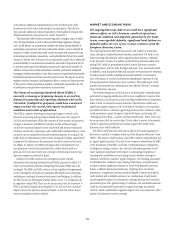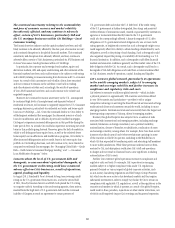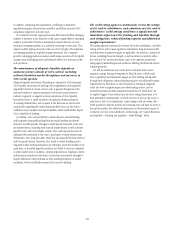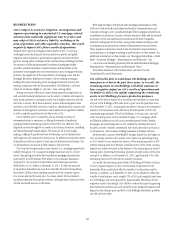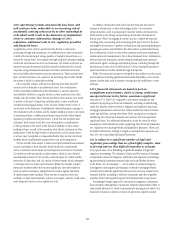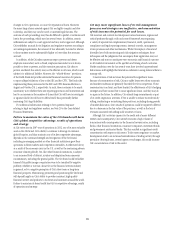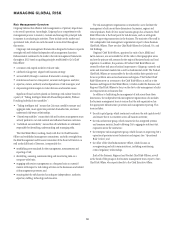Citibank 2011 Annual Report Download - page 82
Download and view the complete annual report
Please find page 82 of the 2011 Citibank annual report below. You can navigate through the pages in the report by either clicking on the pages listed below, or by using the keyword search tool below to find specific information within the annual report.60
The continued uncertainty relating to the sustainability
and pace of economic recovery and market volatility
has adversely affected, and may continue to adversely
affect, certain of Citi’s businesses, particularly S&B and
the U.S. mortgage businesses within Citi Holdings – Local
Consumer Lending.
The financial services industry and the capital markets have been and will
likely continue to be adversely affected by the slow pace of economic recovery
and continued disruptions in the global financial markets. This continued
uncertainty and disruption have adversely affected, and may continue to
adversely affect, certain of Citi’s businesses, particularly its S&B business and
its Local Consumer Lending business within Citi Holdings.
In particular, the corporate and sovereign bond markets, equity and
derivatives markets, debt and equity underwriting and other elements of the
financial markets have been and could continue to be subject to wide swings
and volatility relating to issues emanating from Eurozone and U.S. economic
issues. As a result of this uncertainty and volatility, clients have remained
and may continue to remain on the sidelines or cut back on trading
and other business activities and, accordingly, the results of operations
of Citi’s S&B businesses have been and could continue to be volatile and
negatively impacted.
Moreover, the continued economic uncertainty in the U.S., accompanied
by continued high levels of unemployment and depressed values of
residential real estate, will continue to negatively impact Citi’s U.S. Consumer
mortgage businesses, particularly its residential real estate and home equity
loans in Citi Holdings – LCL. Given the continued decline in Citi’s ability to
sell delinquent residential first mortgages, the decreased inventory of such
loans for modification and re-defaults of previously modified mortgages,
Citi began to experience increased delinquencies in this portfolio during the
latter part of 2011. As a result, Citi could also experience increasing net credit
losses in this portfolio going forward. Moreover, given the lack of markets in
which to sell delinquent home equity loans, as well as the relatively fewer
home equity loan modifications and modification programs, Citi’s ability to
offset increased delinquencies and net credit losses in its home equity loan
portfolio in Citi Holdings has been, and will continue to be, more limited as
compared to residential first mortgages. See “Managing Global Risk—Credit
Risk—North America Consumer Mortgage Lending” and “—Consumer
Loan Modification Programs” below.
Concerns about the level of U.S. government debt and
downgrade, or concerns about a potential downgrade, of
the U.S. government credit rating could have a material
adverse effect on Citi’s businesses, results of operations,
capital, funding and liquidity.
In August 2011, Standard & Poor’s lowered its long-term sovereign credit
rating on the U.S. government from AAA to AA+ and in the second half
of 2011, Moody’s Investors Services and Fitch both placed the U.S. rating
on negative outlook. According to the credit rating agencies, these actions
resulted from the high level of U.S. government debt and the continued
inability of Congress to reach an agreement to ensure payment of
U.S. government debt and reduce the U.S. debt level. If the credit rating
of the U.S. government is further downgraded, the ratings and perceived
creditworthiness of instruments issued, insured or guaranteed by institutions,
agencies or instrumentalities directly linked to the U.S. government
could also be correspondingly affected. A future downgrade of U.S. debt
obligations or U.S. government-related obligations by one or more credit
rating agencies, or heightened concern that such a downgrade might occur,
could negatively affect Citi’s ability to obtain funding collateralized by such
obligations as well as the pricing of such funding. Such a downgrade could
also negatively impact the pricing or availability of Citi’s funding as a U.S.
financial institution. In addition, such a downgrade could affect financial
markets and economic conditions generally and the market value of the U.S.
debt obligations held by Citi. As a result, such a downgrade could lead to a
downgrade of Citi debt obligations and could have a material adverse effect
on Citi’s business, results of operations, capital, funding and liquidity.
Citi’s extensive global network, particularly its operations
in the world’s emerging markets, subject it to emerging
market and sovereign volatility and further increases its
compliance and regulatory risks and costs.
Citi believes its extensive and diverse global network—which includes
a physical presence in approximately 100 countries and services offered
in over 160 countries and jurisdictions—provides it with a unique
competitive advantage in servicing the broad financial services needs of large
multinational clients and customers around the world, including in many
emerging markets. International revenues have recently been the largest and
fastest-growing component of Citicorp, driven by emerging markets.
However, this global footprint also subjects Citi to a number of risks
associated with international and emerging markets, including exchange
controls, limitations on foreign investment, socio-political instability,
nationalization, closure of branches or subsidiaries, confiscation of assets
and sovereign volatility, among others. For example, there have been recent
instances of political turmoil and violent revolutionary uprisings in some
of the countries in which Citi operates, including in the Middle East, to
which Citi has responded by transferring assets and relocating staff members
to more stable jurisdictions. While these previous incidents have not been
material to Citi, such disruptions could place Citi’s staff and operations
in danger and may result in financial losses, some significant, including
nationalization of Citi’s assets.
Further, Citi’s extensive global operations increase its compliance and
regulatory risks and costs. For example, Citi’s operations in emerging
markets subject it to higher compliance risks under U.S. regulations
primarily focused on various aspects of global corporate activities, such
as anti-money-laundering regulations and the Foreign Corrupt Practices
Act, which can be more acute in less developed markets and thus require
substantial investment in order to comply. Any failure by Citi to remain in
compliance with applicable U.S. regulations, as well as the regulations in the
countries and markets in which it operates as a result of its global footprint,
could result in fines, penalties, injunctions or other similar restrictions, any
of which could negatively impact Citi’s earnings and its general reputation.



